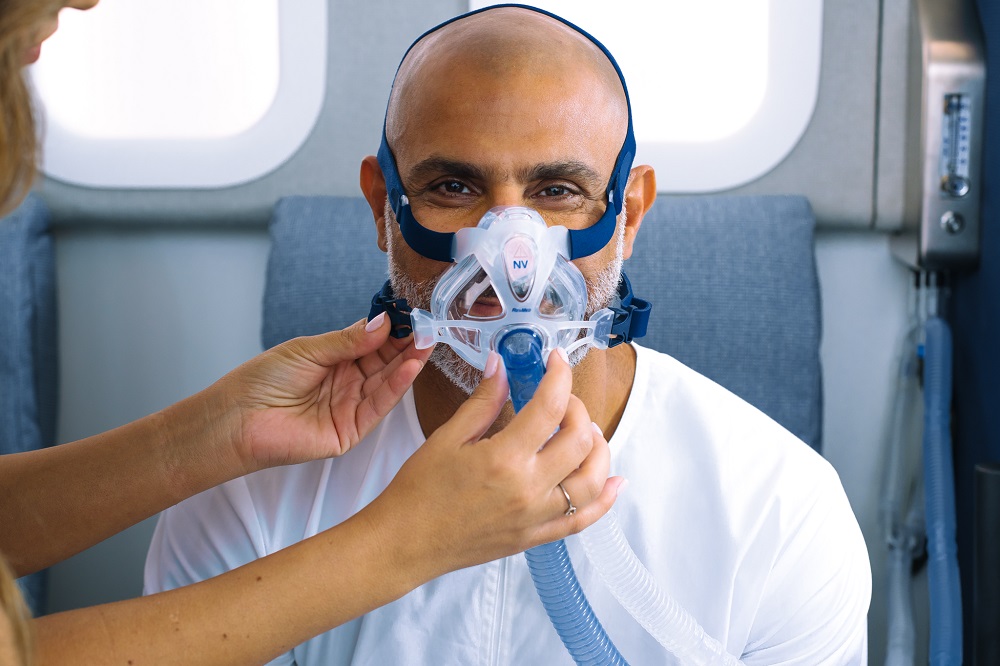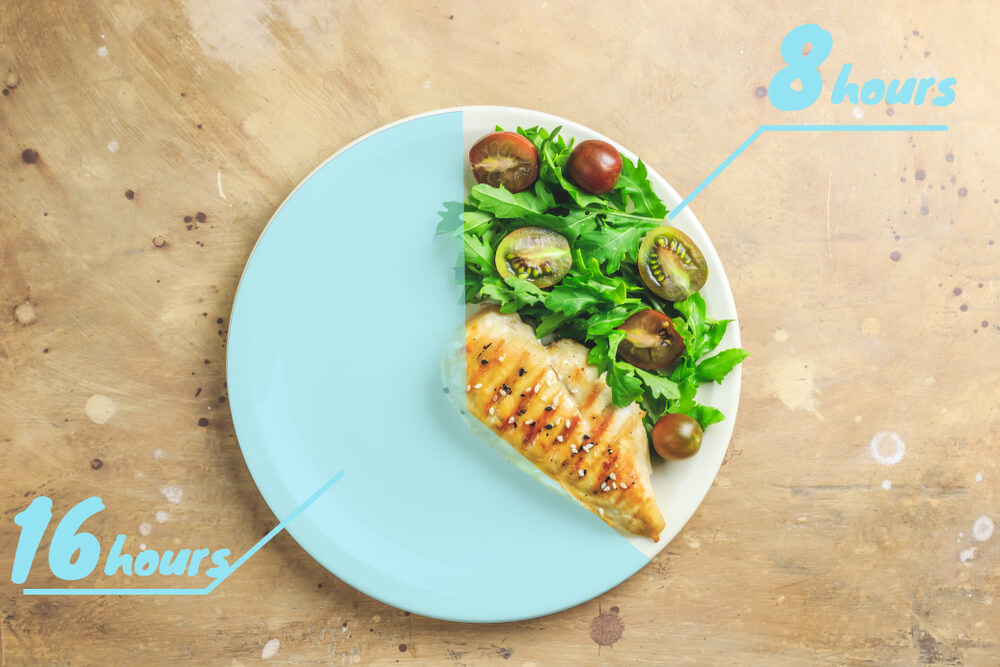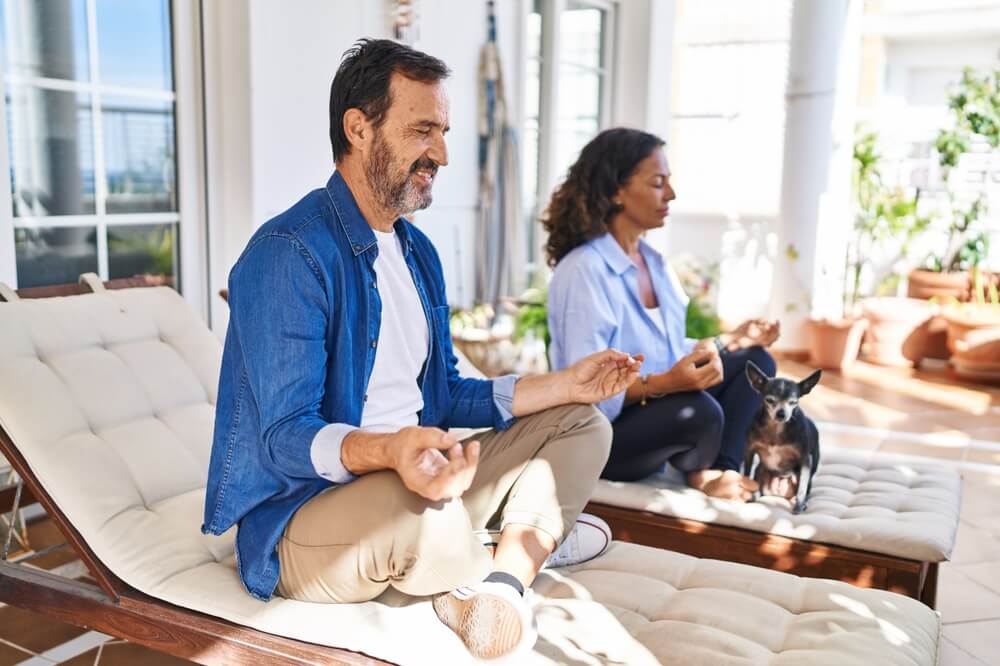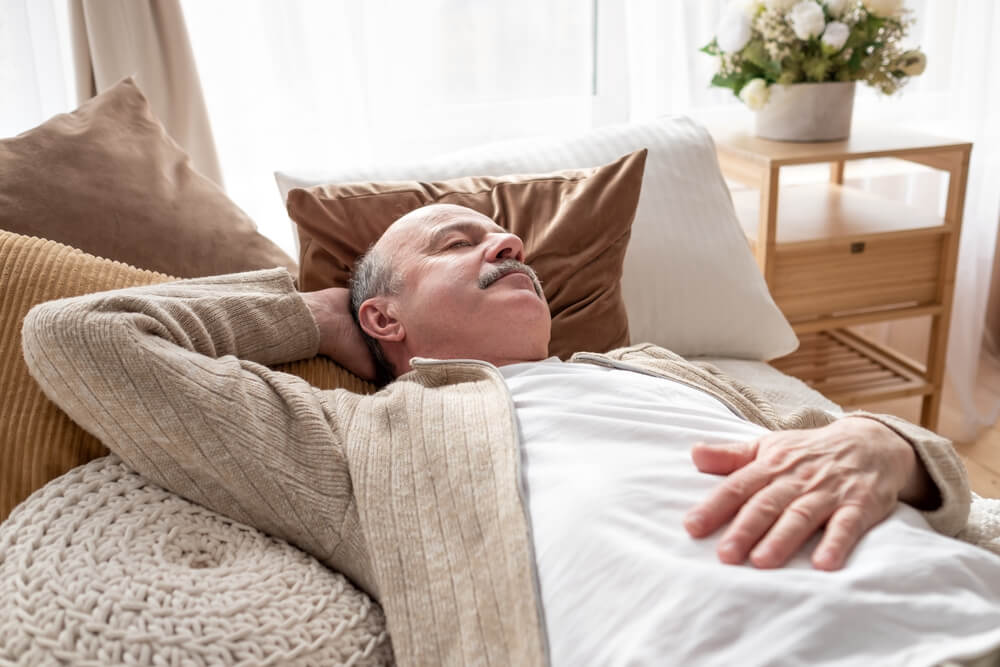How to Increase Your Blood Oxygen Levels: 21 Actionable Tips
How to Increase Your Blood Oxygen Levels: 21 Actionable Tips
Oxygen. It’s the lifeblood of our existence. It’s what helps our bodies function. It’s what helps us move and think, enabling us to achieve our daily goals, both big and small.
For our bodies to function, our cells need energy. Oxygen is the fuel that allows our cells to break down the glucose in our foods to create this energy. Blood vessels transport oxygen-rich red blood cells throughout our bodies, nourishing our tissues and allowing this process of energy production, or cellular respiration, to occur.
As we age, oxygen levels can wane. Blood vessels grow narrower, limiting the transportation of oxygen to red blood cells. This is one reason why we might feel physically and cognitively weaker.
If you’ve been wondering how to increase blood oxygen levels, you’re in luck. At The Brain & Performance Centre, we aim to defy limitations—getting older shouldn’t mean pressing the brake on your life. With the right resources and the benefits of more oxygen in your blood, you can take your foot off the brake and move forward confidently.

Understanding Blood Oxygen Levels
Your blood oxygen level (also referred to as blood oxygen saturation) is the amount of oxygen you have in your blood. Two main tests are available to measure your blood oxygen level—pulse oximetry and a blood draw test.
- A normal oxygen level using pulse oximetry (a small device often clipped onto your fingertip) is between 95% and 100%.
- For a blood draw, laboratories have different reference ranges and will have details regarding the normal oxygen range. Reach out to your lab or doctor if you have questions.
Low oxygen levels often indicate:
- Heart conditions
- Lung conditions, such as asthma and bronchitis
- Inflammation
- Sleep apnea
- A high-altitude environment
21 Quick and Actionable Tips on How to Increase Oxygen in Blood
Boosting oxygen levels involves these 21 actionable tips, organized by category.

Exercise Regularly
- Cardio: Cardio exercises increase your breathing rate, which helps you absorb more oxygen.
- Stretching: Stretching helps your muscles receive more blood, oxygen, and nutrients.
- Maintain a healthy weight: Excessive weight can strain the respiratory system and reduce lung capacity. Keeping a healthy weight can improve lung function and increase blood oxygen levels.
Maintain a Healthy Diet
What foods increase oxygen in the blood? To enrich your oxygen levels through a healthy diet, you should:
- Consume dark leafy greens: Leafy greens such as kale and spinach increase blood oxygen. They contain nitrogen, which “plays a major role in delivering oxygen throughout the body.”
- Incorporate iron-rich foods: Foods like white beans, tofu, and dark chocolate contain iron—an “essential element for blood production.”
- Snack on antioxidant-rich fruits: Fruits like blueberries and cranberries are high in antioxidants, which promote blood flow and provide more oxygen to tissues.

Maintain Good Posture
- Stand or sit up straight: Research notes “the best oxygenation [is] in the ‘sitting upright’ position.” Lying down for a long period can put pressure on your lungs. Take the time to stand or sit up straight to help increase lung capacity.
Keep Your Lungs Healthy
- Drink plenty of water: Well-hydrated lungs are more efficient at dispersing oxygen into your bloodstream. The average daily water intake for “men is about 15.5 cups and for women, about 11.5 cups.”
- Go outside: There’s nothing like a breath of fresh air to promote more oxygen flow. Not to mention, you’ll also get to take in the sunshine and some vitamin D!

Practice Deep Breathing Techniques
- Diaphragmatic breathing: Also called belly breathing, diaphragmatic breathing provides positive oxygenation effects.
- Sit up straight, one hand on your stomach, the other on your chest.
- Breathe slowly through the nostrils. In addition to your chest rising, you should also feel your stomach area expand with each full, diaphragmatic breath.
- Exhale slowly out your mouth.
- Repeat six or more times per minute for up to 15 minutes.
Minimize Exposure to Air Pollutants and Toxins
- Get indoor plants: House plants help remove organic chemicals in the indoor air.
- Set up an air purifier: An air purifier helps trap dust, pollen, and bacteria and disperses clean air back into your home.
- Choose electric over gas: For example, you may opt for an electric stove rather than a gas stove to avert indoor pollution.
- Quit smoking: Smoking has a detrimental effect on oxygen circulation. Make a plan to quit smoking and avoid second-hand smoke.

Improve Sleep Quality
- Stay consistent with your sleep schedule: Being well-rested is vital for maintaining healthy oxygen levels. Get up and go to bed at the same time each night. This consistency reinforces your body’s sleep-wake cycle.
- Limit naps: While sleeping during the day makes up for lost sleep, long naps might make it harder for you to fall asleep at night.
- Stay clear from caffeine: The general rule of thumb is to have a caffeine cut-off time of a “minimum of eight hours before bedtime.”
- Regulate bedroom temperature: An environment that is too hot or too cold is not conducive to good sleep. Keep your bedroom at a cool, but comfortable temperature.
Reduce Stress
- Connect with loved ones: When we feel stressed, our breathing becomes shallow. This inhibits healthy oxygen flow to the bloodstream. Reaching out to trusted friends and family members can help you feel supported and more grounded.
- Take on a hobby: A new hobby such as crocheting, baking, or writing can offer a healthy distraction and put your mind at ease.
- Seek therapy: Therapy offers a safe space to voice and process your concerns and discover healthy coping mechanisms.
The Power of Hyperbaric Oxygen Therapy (HBOT) in Increasing Blood Oxygen Level

All the above tips are good to implement on a day-to-day basis, but when you feel age-related decline coming on, additional measures might be needed.
Hyperbaric oxygen therapy (HBOT) is a significant way to help increase your blood oxygen levels. HBOT involves sitting in a pressurized chamber and breathing in 100% oxygen. Research has shown that breathing oxygen in a pressurized environment improves circulation and allows more oxygen to be absorbed into the bloodstream.
The Brain & Performance Centre uses a unique, specialized HBOT protocol inside its state-of-the-art hyperbaric suites, which includes precise fluctuations of oxygen levels during each HBOT session.
This specific HBOT protocol not only elevates levels of oxygen in the body, but also encourages your body to unlock its self-healing mechanisms.
Thanks to the biological progressions HBOT offers, The Brain & Performance Centres medical team has been able to help patients better manage conditions such as age-related concerns, traumatic brain injuries and stroke.

Take Charge of Your Health and Wellbeing
We encourage you to bookmark this page and practice these tips for increasing your blood oxygen levels and for making positive lifestyle changes.
Explore The Brain & Performance Centre for more information on our evidence-based hyperbaric oxygen therapy protocol and comprehensive health assessment or contact us to learn how we can help.
Your Health Is Your Wealth: The Importance of Investing in Your Health
The daily choices we make and the activities we engage in impact our quality of life. While health problems and expenses might be an expected norm with age, there are ways you can minimize or even avoid them altogether.
At The Brain & Performance Centre, we believe making more conscious decisions today will give you the health span you deserve. Learn the importance of investing in your health and nine ways to get started.
Note: Speak to your doctor before you pursue any lifestyle changes.
1. Consider the MIND Diet
Eating healthy has been a consistent mantra over the years, and for good reason—there is a connection between diet and disease. A healthy diet is the foundation for feeling good.
While there are numerous diet trends out there, there is one truly worth your time and investment—the MIND diet.
The Mediterranean-DASH Intervention for Neurodegenerative Delay (MIND) diet is a blend of two highly effective diets:
- Mediterranean: Consists of a heart-healthy eating plan
- DASH: Aims to address hypertension or high blood pressure
Studies illustrate the MIND diet is “associated with reduced incidence of Alzheimer’s disease.”
Sticking to this diet that entails a variety of fruits and vegetables provides anti-inflammatory effects on the brain. This impact can strengthen brain cell structure and help regulate anxiety and mood.
2. Engage in Intermittent Fasting
We know—fasting doesn’t sound like the most exciting thing. But consider intermittent fasting. Not only can you achieve a healthy body composition, but you can also improve your brain health—all without strict dietary restrictions.
Intermittent fasting is a dietary lifestyle that comprises alternating periods of eating and fasting and limiting the number of hours you consume calories during the day/week.
This metabolic switching:
- “Promotes neuroplasticity and resistance of the brain to injury and disease”
- May “decrease the progression of Alzheimer’s disease in mice through changes to the gut microbiota”

3. Stay Educated on Fall Prevention Tactics
“Falls in older adults are a reasonably common occurrence.” Conditions that become prevalent as we age (e.g., muscle weakness, osteoporosis, and balance and gait problems) make us more susceptible to falls.
The key ingredient to prevention? Exercise. This entails:
- Strength training
- Cardio training
- Balance training
- Flexibility training
Other fall prevention tactics are just as important.
- Keep your home clear of clutter and trip hazards such as cords, books, shoes, etc.).
- Install grab bars in the bathroom and handrails in the hallways and stairways.
- Avoid wearing clothing that drags on the ground.
- Wear non-slip socks or shoes around the house.
- Take a pause after standing up and before beginning to walk.
4. Find Helpful Ways to Cope with Stress
Stress is inevitable, and the body and mind are biologically equipped to handle it. But sometimes, when the stress gets overwhelming, it can have adverse effects. ”Stress affects not only memory and many other brain functions, like mood and anxiety, but also promotes inflammation.”
Chronic stress can:
- Kill brain cells.
- Cause memory decline.
- Negatively impact mental health.
Whether you are grieving or dealing with a major change in your life, it’s essential to find healthy coping mechanisms for stress:
- Make time for physical activity: At The Brain & Performance Centre, we recommend 30 minutes of exercise three days a week at a minimum. Exercise benefits the brain by releasing endorphins, helping relieve pain, and improving mood. The key is to find an activity you enjoy—this will make exercise fun and feel less like a chore.
- Be conscientious about screen time. Experts say, “The goal isn’t to eliminate screens from your life; it’s to imbue the time you spend on screens with ‘intentionality.’” When used wisely and with purpose, technology offers worthy benefits. But misusing it can cause more harm than good. Thus, stay aware and focus on balancing screen time with other activities.
- Meditate. Not only is meditation a great activity to do instead of “doom scrolling” on your screen, but meditation may promote several benefits such as “reduction of cognitive decline” and “increase in quality of life.”

5. Focus on Body Composition Instead of Weight
A low number on the bathroom scale doesn’t necessarily mean all is well. Indeed, society’s obsession with the scale can lead to problems like declining muscle mass—a condition that will do more harm than good later in life.
So toss that unhealthy relationship with the bathroom scale. Instead, look at your overall body composition.
For example, The Brain & Performance Centre uses the seca scale to get a precise rundown of the meaning behind a person’s weight. This scale helps us develop an accurate and customized treatment plan—losing body fat, gaining muscle, or a combination of both.
Speak to your doctor to gain a comprehensive assessment of your body composition so you can make appropriate, personalized goals.
6. Stick to a Consistent Sleep Schedule
Since the sleep hormone melatonin naturally decreases with age, it’s vital to set up healthy sleeping habits. This entails turning off all electronics an hour before bedtime and getting in bed at the same time each night. Doing so will promote natural circadian rhythms and maintain cognitive health.

7. Engage in Games
Investing in your health doesn’t have to be boring—it can include games!
That’s right, playing brain games is a fun and active way to train your brain. Researchers report “the effectiveness of cognitive intervention in maintaining cognitive health over the long-term.”
The brain functions similarly to muscles building muscle fibers after exercise—it promotes new neurons and neuronal connections after participating in games.
8. Listen to More Music
When was the last time you truly listened to music? What kinds of images and memories did it elicit?
Music offers far more advantages than helping you get through a grueling drive or setting the tone for a party. The best part is these benefits are backed by research.
Studies illustrate music can:
- Improve “cognitive function in people living with dementia, as well as quality of life after the intervention and long-term depression.”
- Reduce “measures of anxiety in a population of residential care patients with dementia.”
- Provide “better sleep quality” for “adults who listened to 45 minutes of music before going to sleep.

9. Find a Research-Backed HBOT Programme
Hyperbaric oxygen therapy (HBOT) is a treatment in which the patient breathes 100% pure oxygen in a pressurized chamber. The Brain & Performance Centre’s luxury, state-of-the art hyperbaric oxygen therapy suites are the largest and most advance in Dubai and the surrounding region.

Several studies illustrate the potential of HBOT in improving cognitive, physical, and psychological performance when administered in a specific protocol. The Brain & Performance Centre’s HBOT protocol fluctuates oxygen levels during each hyperbaric session. This system increases oxygen levels in the body up to 20 times higher than normal and boosts your brain’s ability to heal.
The unique medical programme at The Brain & Performance Centre consists of a treatment programme that include this same research-backed HBOT protocol along with cognitive training, dietary coaching, and physical performance training in a physician-designed programme tailored to each client’s needs.
This holistic approach gives each patient the personalized care they deserve for their unique health conditions. Our clients have optimized their athletic performance with HBOT and have found relief from debilitating medical conditions such as stroke and traumatic brain injury.
Invest in Your Health at The Brain & Performance Centre
The Brain & Performance Centre stands by a holistic treatment programme that targets all areas discussed above. A series of independent clinical trials illustrate how our programme helps treat the symptoms of different health conditions.
Rehabilitation Options, Including Hyperbaric Oxygen Therapy (HBOT), for Stroke Patients
Strokes are “a leading cause of serious long-term disability”. Given that “87% of all strokes are ischemic” or caused by artery or vein blockage, it makes sense that most patients suffer long-term functional impairments.
These impairments can range from paralysis, speech difficulties, and sensory issues to a host of other cognitive dysfunctions. Additionally, many stroke patients have had a stroke before—“nearly 1 in 4” survivors have suffered at least one stroke previously.
Rest assured, multiple rehabilitation options are available for stroke patients, including hyperbaric oxygen therapy (HBOT). We dive into the key details below.
Remember that each person’s medical condition and background are entirely unique. Thus, speaking with a physician about treatment options is essential to getting back to optimal health.
What Are the 3 Common Stroke Relief Options?
Stroke relief generally entails working with a diverse medical team of physicians, nurses, and therapists. This support team may recommend one or more of the following options:
1. Speech therapy:
Stroke patients can experience speech challenges, ranging from slurred world to significant difficulties with oral communication or understanding people (aphasia). This is due to damage to the “left side of the brain that controls speech and language.” Cases like this often merit speech therapy.
Patients work with speech-language pathologists (SLPs) to relearn techniques such as:
- Controlling mouth and throat muscles to speak more clearly and adequately swallow
- Participating in cognitive language exercises to restore communication and comprehension skills
Research illustrates early speech intervention with aphasia patients “had a massive increase in their ability to communicate at 12 and 26 weeks after their stroke.” Patients could speak better and exhibited less difficulty finding and using the right words.
2. Physical therapy:
A physical therapist (PT) engages patients in movement exercises to help them reacquire motor skills. PTs generally help stroke patients relearn activities such as walking, sitting, standing, and switching from one movement to another.
Medical experts believe consistent PT lowers “risks of hospital readmission within a month after discharge” because it helps patients:
- Restore movement and accomplish tasks
- Plan for the next step of post-acute care (e.g., patient rehab facility, skilled nursing facility, or home care assistance)
3. Occupational therapy:
Occupational therapists help patients carry out everyday activities. They aim to help stroke patients live as independently as they can. OTs work with post-stroke patients to assess how the stroke has affected their lifestyle.
For those who have difficulties dressing, cooking, or bathing, the OT will find solutions to help carry out these activities of daily living to the best of their ability. These statistics outline the importance of OT in the recovery process.
- One study of Medicare claims data found that “Rehabilitation services including physical therapy and occupational therapy play important roles in promoting functional recovery and preventing deconditioning during acute hospitalizations.” However, “Only 61% of patients with ischemic stroke received both physical therapy and occupational therapy services in the acute setting.”
One study notes that patients who participated in OT programmes focused on impairment and basic living activities “progressed to more advanced activities over time (e.g., less bed mobility, more home management).”
The Groundbreaking Therapeutic Approach of Hyperbaric Oxygen Therapy

An up-and-coming therapy for long-term stroke recovery that has shown promise in clinical research is Hyperbaric Oxygen Therapy (HBOT).
HBOT has clear indications of brain-cell rehabilitation in patients suffering from post-stroke disabilities.
HBOT and its apparent benefits for post-stroke patients were studied and reviewed in an article published in the peer-reviewed journal PLOS One:
- The participants were exposed to a unique protocol, including daily HBOT sessions over two months. All the patients showed improved neurological functioning, indicating “that HBOT can lead to significant neurological improvements in post stroke patients even at chronic late stages.”
- Noticeable recovery included “regained speech (almost fluent) and reading capabilities.” Even in patients with less dramatic results, everyday tasks like bathing and dressing became possible unaided by the end of the treatment period.
- Patients were further assessed using brain metabolism imaging (SPECT scans) to examine brain activity during the HBOT treatment. “The SPECT after HBOT demonstrated the disappearance of the perfusion lesions.”
- The study indicated a link between oxygen and stroke—“increasing the plasma oxygen concentration with hyperbaric oxygenation is a potent means of delivering to the brain sufficient oxygen for tissue repair.”
Not only did the study determine significant improvements in patients treated with HBOT, it crucially found that the progression occurred in patients even many months after the stroke event.
The study’s objective was to “evaluate the effects of HBOT started in the late-chronic phase after the acute stroke.” All the patients experienced strokes between six and 36 months prior to the HBOT treatment.

The Brain & Performance Centre: The Road to a Better Life
Backed by over a decade of research, The Brain & Performance Centre can include HBOT, along with cognitive training, dietary coaching, and physical performance training to help you recover even long after a stroke.
The programme aims to offer patients a customized, coordinated, and multidisciplinary health plan to address their specific goals. As the aging process affects every person differently, each plan is individualized based on a patient’s post-stroke recovery needs.
Here’s how our process works:
- Assessment: Our dedicated team will conduct a thorough assessment to gain a holistic understanding of your health and craft a personalized health plan.
- Treatment: Under the supervision of our medical staff, the treatment plan will entail a variety of health programmes that are meant to get you on the road to recovery.
- Analysis: We will track data on how your treatment plan is progressing and make the necessary adjustments along the way.
- Follow-up: Upon conclusion of the treatment, our team will continue to follow up on your progress via a wearable device. This will allow us to send you reports on your health and performance.
Watch Hussain’s Inspiring Recovery Story:
A true inspiration and a shining example of strength and determination. After experiencing a stroke, he embarked on his recovery journey at the Brain & Performance Centre, embracing every challenge with remarkable courage.
Is The Brain & Performance Centre Right for You?
If you’ve been experiencing cognitive or physical challenges since your stroke, The Brain & Performance Centre may be able to help. We have treated thousands of patients suffering from various conditions, enhancing their quality of life.
We encourage you to speak with one of our licensed medical staff to see if it’s right for you, as each person’s body, medical history, and circumstances differ. Our staff will take the time to understand your health history, symptoms, and goals. This process will help us determine whether The Brain & Performance Centre protocol is a good fit.
How Long Does It Take to See Results?
Improving physical and cognitive performance does not happen overnight. The Brain & Performance Centre requires time and careful compliance to achieve success.
HBOT sessions take approximately two hours daily, five days a week, for 8-12 weeks. However, this timeline may vary across patients. Our clients see members of The Brain & Performance Centre healthcare team for additional therapies or coaching (e.g., cognitive training, dietary coaching, and physical performance training) multiple times each week.
Learn More about Post-Stroke Recovery
If you need help finding a stroke recovery plan, contact The Brain & Performance Centre. Our diverse team of medical professionals is experienced in crafting customized treatment plans that have brought significant and fulfilling results for our patients. Improving your quality of life begins here.
Anti-Aging Effects of Hyperbaric Oxygen Therapy (HBOT) Shown to Reverse Aging Biomarkers in Humans
A landmark study has found that hyperbaric oxygen therapy (HBOT) can reverse two key biological signs of aging in humans—the first study to ever make this finding.
Published in the peer-reviewed journal Aging, the study shows that it is possible to target and reverse the aging process at the basic cellular-biological level.
This breakthrough in the biology of aging provides scientists with a new foundation for investigating ways to slow the aging process. Learn more about the empirically validated anti-aging effects HBOT can have.

The 2 Key Biological Signs of Aging
Two common signs of biological aging are:
- Shortening of telomeres on our chromosomes: Telomeres are like the hardened ends of shoelaces. They protect the ends of chromosomes from deterioration. As we age, our telomeres naturally shorten, but a yearly decrease of their length by 20–40 bases is associated with serious illnesses.
- Accumulation of senescent cells: Senescent cells are cells that are still alive, but have stopped multiplying. Over time, these cells can accumulate in the body and their increase contributes to age-associated conditions.
In the groundbreaking study, patients aged 64 and older underwent a series of unique HBOT anti-aging programmes. Multiple blood tests conducted during the study showed “HBOT may induce significant senolytic effects including significantly increasing telomere length and clearance of senescent cells in the aging populations.” Learn More
The “Holy Grail” of the Biology of Aging
A different study released in 2020 showed that HBOT also improves cognitive functions of memory and processing speed, among other areas.
The studies have been conducted over a decade of research and caused Dr. Shai Efrati—the study’s co-author—to develop a unique medical programme available at The Brain & Performance Centre.
According to Efrati, director of the Sagol Centre for Hyperbaric Medicine and Research at the Shamir Medical Centre:
“After dedicating our HBOT research to exploring its impact on the areas of brain functionality and age-related cognitive decline, we have now uncovered for the first time in humans HBOT’s biological effects at the cellular level in healthy aging adults.”
Efrati called telomere shortening “the ‘Holy Grail’ of the biology of aging” and developed The Brain & Performance Centre based upon the results testing, study, and research.
“The significant improvement of telomere length shown during and after these unique HBOT protocols provides the scientific community with a new foundation of understanding that aging can, indeed, be targeted and reversed at the basic cellular-biological level.”

Study Findings on Anti-Aging Effects of HBOT
- “Telomeres length of T helper, T cytotoxic, natural killer and B cells increased significantly by over 20% following HBOT”
- “There was a significant decrease in the number of senescent T helpers by -37.30%±33.04 post-HBOT.”
According to Dr. Amir Hadanny (co-author of the study) the pioneering study has:
“Opened the door for further research on the prolonged cellular impact of HBOT to reverse the aging process. In just three months of HBOT, we were able to achieve such significant telomere elongation—at rates far beyond any of the currently available interventions or lifestyle modifications.”
There is also the potential for HBOT to be used as an anti-aging mechanism for skin care. HBOT may serve as “an important component in skin rejuvenation, treatment of photoaging skin, and improvement in skin complexions.”
Notable Individuals Who Have Pursued HBOT
Due to the impressive data-backed results, many notable individuals have decided to pursue HBOT themselves:
- Michael Phelps: 28-time Olympic medalist used hyperbaric oxygen therapy to help with his recovery from training. The high-altitude conditions and boosted levels of oxygen have aided in helping Phelps bounce back from his workouts and continue to win medals throughout his 24-year career.
- Justin Bieber: Having been diagnosed with Lyme Disease and dealt with drug abuse, the pop star regularly uses hyperbaric oxygen therapy. Bieber, who also mentioned he struggles with anxiety and depression, notes that HBOT helps alleviate his stress levels.
- Alon Day: The demands of professional racing are high, with reaction times measured in fractions of a second. Watch three-time NASCAR Whelen Euro Series champ Alon Day explain how the treatments offered by the The Brain & Performance Centre ensure he meets the sport’s high demands — both mental and physical.
The Brain & Performance Centre: What We Offer
The unique HBOT protocol from the extensive research outlined earlier is available in the United States only at The Brain & Performance Centre. The Brain & Performance Centre may include a combination of:
- In-depth review of health history
- Comprehensive physical exam
- Highly advanced brain imaging scans
- Neurological and neurocognitive tests
- Body composition analysis
- A detailed report of our assessment findings
- Cognitive training
- Physical training
- Dietary coaching
- Hyperbaric oxygen therapy (HBOT)
- A post-programme report of your improvements and recommendations for future progress
Each patient undergoes extensive assessments and evaluations before, during, and after their HBOT sessions to monitor and analyze progress.
For more information about The Brain & Performance Centre – Click here.